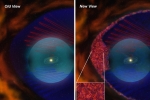‘Comet Of The Century’ Passes By Mars: When Will ISON Be Visible From Earth?

It's rare to catch a celestial show as awe-inspiring as a comet. Witnessing with the naked eye a glowing white streak in the sky, like the one that appears every 75 years when Halley's Comet makes a pass by Earth, is a treat for any amateur or avid stargazer. That could be the case in November when ISON, a comet discovered last year and dubbed the "comet of the century," gets closer to the sun. That is, if ISON makes it that far.
Like Us on Facebook
The comet is about to make a brush by Mars. Space.com reports that on October 1, ISON will be within .07 AU - or 6.5 million miles - of the Martian surface. It's on a kamikaze mission towards the sun, and when it gets closer, it'll begin to shed its icy shell, giving it that tail we all want to see. According to NASA, the "comet of the century" could be brighter than the full moon.
But Reuters reports that ISON may already be fizzling out.
"The future of comet ISON does not look bright," astronomer Ignacio Ferrin, with the University of Antioquia in Colombia, said in a statement on Monday, according to Reuters. "Comet ISON has been on a standstill for more than 132 days ... a rather puzzling feat,"
Russian astronomers discovered the "comet of the century" in September 2012. ISON is named for the telescope that first gazed on the comet. The International Scientific Optical Network, managed by the Russian Academy of Sciences, is a group of 10 observatories around the world that track and monitor all the stuff floating around in space.
Union Bulletin reports that ISON is just now passing through the "frost line," the distance from the sun at which the comet's ice will begin to burn off. "At this point the water locked in the 3-mile-wide nucleus should begin to sublimate - change from a solid directly to a gas," Union Bulletin reports. "This process creates jets of gas and dust that should cause the comet to brighten even more."
The problem is, the temperatures created by the sun could be too hot for the comet to handle, causing it to vaporize.
The comet is slated to pass within 720,000 miles of the solar surface on November 28. If it isn't instantly vaporized, that's when the "comet of the century" will be at its brightest.
"If ISON's nucleus is much bigger than 0.5 km, it will probably survive its Thanksgiving Day brush with the sun," astronomer Carey Lisse of the Johns Hopkins University Applied Physics Lab said in a statement, according to Space.com. "It could turn into one of the most spectacular comets in many years."
Read more from iScience Times:
Comet ISON: Could the Comet of the Century Hit Earth in 2013? [PHOTO & VIDEO]
Comet Coming In 2013 Brighter Than Full Moon: ISON Could Be The 'Comet Of The Century'
Moon Passing Jupiter: Stargazers Will Witness The Amazing Lunar Occultation And Comets [VIDEO]
© 2012 iScience Times All rights reserved. Do not reproduce without permission.

25 Year Study Reveals Eco-Farming To Be Economically Feasible And Sustainable

How Methane-Producing Microbes Caused The Largest Mass Extinction The World Has Ever Seen

Terrifying Animatronic Robot Dances To 'Blurred Lines,' Causes Nightmares [VIDEO]

Scientists Demonstrate Three-Way Quantum Communication: What's Faster Than The Speed Of Light?

Woolly Mammoth DNA To Be Cloned, Then Joined With Elephant DNA To Create New Creature

Oculus Rift Headset Will Take You On A Trip To Space, All From The Comfort Of Your Couch



![How to Turn Your Tap Water Faucet Into a Coffee Spout [VIDEO]](../../../cdn-sub/data/thumb/mainpage/6005-150100-coffee.jpg)

